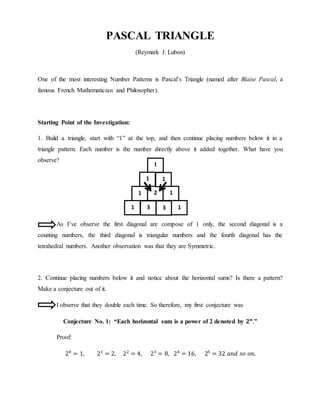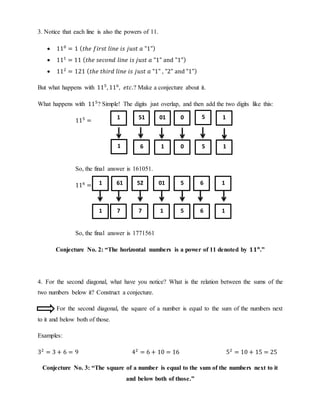Pascal Triangle
- 1. PASCAL TRIANGLE (Reymark J. Lubon) One of the most interesting Number Patterns is Pascal‚Äôs Triangle (named after Blaise Pascal, a famous French Mathematician and Philosopher). Starting Point of the Investigation: 1. Build a triangle, start with ‚Äú1‚Äù at the top, and then continue placing numbers below it in a triangle pattern. Each number is the number directly above it added together. What have you observe? As I‚Äôve observe the first diagonal are compose of 1 only, the second diagonal is a counting numbers, the third diagonal is triangular numbers and the fourth diagonal has the tetrahedral numbers. Another observation was that they are Symmetric. 2. Continue placing numbers below it and notice about the horizontal sums? Is there a pattern? Make a conjecture out of it. I observe that they double each time. So therefore, my first conjecture was Conjecture No. 1: ‚ÄúEach horizontal sum is a power of 2 denoted by ùüê ùíè .‚Äù Proof: 20 = 1, 21 = 2, 22 = 4, 23 = 8, 24 = 16, 25 = 32 ùëéùëõùëë ùë†ùëú ùëúùëõ. 1 1 2 1 1 1 33 11
- 2. 3. Notice that each line is also the powers of 11. ÔÇ∑ 110 = 1 ( ùë°‚Ñéùëí ùëìùëñùëüùë†ùë° ùëôùëñùëõùëí ùëñùë† ùëóùë¢ùë†ùë° ùëé "1") ÔÇ∑ 111 = 11 ( ùë°‚Ñéùëí ùë†ùëíùëêùëúùëõùëë ùëôùëñùëõùëí ùëñùë† ùëóùë¢ùë†ùë° ùëé "1" and "1") ÔÇ∑ 112 = 121 ( ùë°‚Ñéùëí ùë°‚Ñéùëñùëüùëë ùëôùëñùëõùëí ùëñùë† ùëóùë¢ùë†ùë° ùëé "1" , "2" and "1") But what happens with 115 , 116 , ùëíùë°ùëê.? Make a conjecture about it. What happens with 115 ? Simple! The digits just overlap, and then add the two digits like this: 115 = So, the final answer is 161051. 116 = So, the final answer is 1771561 Conjecture No. 2: ‚ÄúThe horizontal numbers is a power of 11 denoted by ùüèùüè ùíè .‚Äù 4. For the second diagonal, what have you notice? What is the relation between the sums of the two numbers below it? Construct a conjecture. For the second diagonal, the square of a number is equal to the sum of the numbers next to it and below both of those. Examples: 32 = 3 + 6 = 9 42 = 6 + 10 = 16 52 = 10 + 15 = 25 Conjecture No. 3: ‚ÄúThe square of a number is equal to the sum of the numbers next to it and below both of those.‚Äù 1 51 01 0 5 1 1 6 1 0 5 1 61 52 01 5 61 1 1 7 7 1 5 6 1


